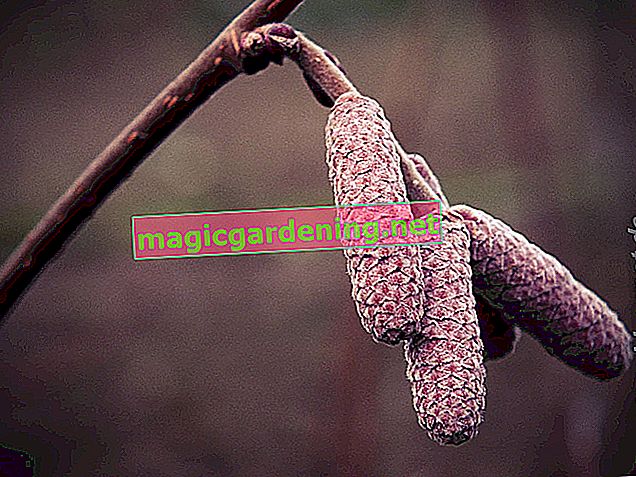
the essentials in brief
- There are few certain facts about the Hanging Gardens of Babylon, and even their very existence is often questioned
- Nowadays there are several famous hanging gardens in the world, including the Bahai World Center in Israel, the Hanging Gardens of Mumbai or the Hanging Gardens of Zion
- A hanging garden is easy to build with plastic bottles
A look at history
One of the seven wonders of the ancient world was a garden as a unique legacy of humanity. At the time, the hanging gardens were in Babylon, which corresponds to today's Iraq. It was one of the most important metropolises in ancient times. However, there is hardly any reliable evidence when the Babylonian wonder of the world existed. The Babylonian King Nebuchadnezzar II, who lived from 605 to 562 BC. Ruled, the building army should have been.
also read
- Hanging trees add variety to the garden
- Is there a hanging variant for men loyal to men?
- The petunia: hanging flower beauty in the balcony box
Historical traditions:
- Antipater of Sidon named the gardens in a poem
- Diodoros Sikulos noted in writing that there was no obvious mechanism for water transport
- Strabo described the geography
- Philo of Byzantium wrote a kind of travel guide to the seven wonders of the world
Impressive staging
The dimensions of the entire system have been handed down. It should have been about 120 meters wide and long and reached a height of 24 meters. The entrance to the garden is said to have been inclined like a slope and covered by huge terrace steps. Countless exotic plants grew on the roofs and water was the determining element.
In order to irrigate the plants, an elaborate system was necessary, which obtained water from the tributaries of the Euphrates. The individual parts of the imposing structure were arranged in steps and crossed by corridors. In this way, the builder succeeded in creating an appearance that should probably remind of a theater. Such images of rushing water and magnificent greenery in the middle of a desert probably fired the imagination.
Mistakes, myths and theses
YoutubeThere are less than a handful of data that have actually been proven. Again and again, researchers come across information that leads to new theses. But to this day it is controversial which facts correspond to the truth and which originate from fantasy.
Name confusion and client chaos
The hanging gardens were actually not really vertical arrangements of plants, but terraced beds. This myth is due to a translation error from Greek into German. The term 'roof garden on terraces' would be more correct. Historians agree that the hanging gardens were not commissioned by Semiramis. She was Queen of Babylonia about 200 years before Nebuchadnezzar II. The king is said to have built the facility for his wife Amyitis.
Unworthy of a wonder of the world
The German archaeologist Robert Koldewey discovered two palaces at the beginning of the 20th century, one of which could have been the garden of the Semiramis. His assumption was supported because the palace contained vaulted substructures, fountains and unusual pottery shards. However, the side length was only 45 meters. For many scientists, such a palace is not worthy of a wonder of the world.
Such gardens were normal for the ancient Babylonians too, as many kings built appropriate facilities for recreation. The Greeks saw these buildings in a different light. Gardens must have been something special for them because they didn't know them. This could have given this little garden its legendary reputation.
Doubtful existence
It is believed that as early as 100 BC Large parts of the hanging gardens of the Semiramis were destroyed. At that time, the people of Babylon left their city. The existence of this powerful system is often questioned. Herodotus, who is regarded as the father of historiography, also does not report anything about the gardens in his traditional work. This universal story, which tells from the rise of the Persian Empire to the Persian Wars, does not contain any detail on the wonder of the world.
Hanging gardens today
The history of these mighty gardens always provides new inspiration. Urban planners, landscape architects and the tourism industry use the idea of hanging gardens for their projects. Plants in the vertical arrangement create a new atmosphere and literally expand the horizon. But even in nature, corresponding structures develop if the conditions permit.
| Where? | What's this? | Specialty | |
|---|---|---|---|
| Hanging Gardens of Ehrenfeld | Cologne | bar | countless plastic roses on the ceiling |
| Vertical living | Singapore | Design project for a better quality of life | green facades, terrace plantations and roof terraces |
| Hanging Gardens Ubud | Bali | Luxury resort | Plant on a slope inclined at 45 degrees |
Jardins suspendus of Le Havre
The hanging gardens were laid out in an old fortress from the 19th century and fit into the remains of the former bulwarks, battlements, trenches and powder chambers. The visitors experience a botanical trip around the world. In various themed gardens, vegetation forms from southern regions, North America and East Asia are shown. In the middle of the courtyard are greenhouses (€ 34.95 on Amazon *) with fragrant plants from the tropics.
Hanging Gardens of Mumbai

In the middle of the residential area of Mumbai, where the upper class lives, lies Malabar Hill. A horticultural work of art has developed here, which is continuously being expanded and redesigned. Countless gardeners prune shrubs and bushes and give them the shape of elephants, monkeys and giraffes. A walk is worthwhile at night. Then the heat of the day has subsided and the largely shadowless facility offers an impressive view over the city lights.
Historic hanging garden in Neufra
This Renaissance garden was commissioned between 1569 and 1573. Count Georg von Helfenstein had the natural castle hill extended by a flat surface supported by vaults up to nine meters high. A garden was built on this level. It is a combination of horticulture and architecture for which the Count was inspired in other countries.
Hanging gardens have always captured the imagination of mankind. They are an oasis of relaxation and a center of inspiration at the same time.
Hanging Gardens of Zion
Zion National Park is located in southwest Utah in the United States. The plateaus, which are divided by numerous gorges, are characteristic. The slopes of these canyons are extremely diverse and divided into small areas. Depending on the nature of the subsoil and the orientation of the sun, completely different ecosystems have developed in the immediate vicinity. Hanging gardens have been created at the places where the water emerges from the rock.
Diverse flora on the walls:
- Ferns and wood sorrel hang meters down below
- Moss beards grow over eroded cliffs
- Yuccas assert themselves on the bare rock of the southern slopes
- crippled junipers despite the scorching sun
- small pines and oaks cling to crevices in the rock
Bahai World Center in Israel

The Hanging Gardens of the Baha'i are located in Haifa on Mount Carmel. They are among the most popular tourist attractions and are not just a place of rest and relaxation. The gardens on the mountainside are a symbol of peace. It was designed by the Iranian architect Fariborz Sahba and shows various elements of Persian gardens. The hanging gardens form an axis that connects the two main religious centers of the Baha'i. In 2008 the garden was named a UNESCO World Heritage Site.
Design ideas for the apartment
Plants in a vertical orientation still fascinate people today. They create a mystical atmosphere and are particularly attractive because of their overhanging shoots and leaves. Due to the large amount of space saved, hanging gardens are becoming increasingly important.
Botanic Horizon
In the Ore Mountains, a manager of a textile company has reinterpreted the theme of the hanging gardens. BOHO or BOTANIC HORIZON is a semi-transparent and vertically structured string system on which useful and ornamental plants grow. This structure enables space-saving installation even in small rooms. The model can be hung up so that it can be used as a decorative element on the wall or as a room divider. The inventor's wealth of ideas does not stand still and so he and his startup went to the lion's den to attract investors.

This is how the hanging garden works:
- Fill in seeds at the nodes
- water from above with nutrient solution
- Plants develop roots around the cords
Vertical green design
Whoever visits Thomas Gessler in his small Kreuzberg shop in Berlin is immersed in a vertical jungle of ornamental and useful plants. Here ferns, tillandsias and ivy grow vertically without soil and surrounded by a frame. From 60 euros there is a piece of jungle for your own four walls. But the business owner also creates vertical vegetable and herb gardens with tomatoes or rocket. The plants grow in a substrate made of open-pored foam, which provides the roots with a secure hold. The irrigation takes place via a water tank or with an atomizer.
Digression
Future ideas
Vertical gardens are also gaining importance in global agriculture. Vertical farming is an idea that aims to ensure a sustainable supply of food to people in metropolitan areas. It is based on multi-story buildings, the so-called farm scrapers. Edible mushrooms, vegetables and fruits as well as algae are to be produced all year round on several superimposed levels. The aim is to save energy costs for transport and minimize carbon dioxide emissions.Design hanging gardens yourself
The Queen Semiramis, who is associated with the hanging gardens, is long history. But the idea of vertically aligned plant arrangements has held up to this day. The difficulty is in finding suitable plants. Not all plants feel comfortable on the wall in poor light conditions. Special plant lamps can help.
Gardens made from PET bottles

You don't necessarily have to buy materials for design. Many things can be transformed into a hanging garden with simple means. Use several PET bottles and embellish them with color, letters or adhesive film. Place the bottles on a table and draw a rectangle on the top of the bottle. This opening is cut out with a craft knife.
Drill two holes in the plastic at the back. A nylon cord is threaded in here, on which the vessels are hung. To prevent them from slipping out of the openings, you should attach the two ends to a small piece of toothpick. Fill the bottles with a substrate suitable for the plants and insert the desired plants.
These plants are suitable:
- Cuisine : basil, chives, marjoram
- Living room : cacti and succulents
- Bath : tillandsias, bromeliads, orchids
Tips
Apply paint with a paint roller. This creates a nice effect.
YoutubeGreen wall for the balcony
Green wall frames are ideal as privacy screens in the garden or on the balcony. But they can also be mounted directly on the facade to embellish it. Lay hoses in the filler that use a pump to transport water from a reservoir and supply the plants. The water drips into the filler through small holes in the hose.
Instructions for building:
- Attach the steel grid to a bare exterior wall
- Attach a plastic net with a mesh size of five millimeters in front of the steel grille
- Glue on the rock wool mat
- Finish the construction with stainless and fine-meshed wire
In this sandwich structure, the plants find enough hold to root and the facade is protected by the plastic film. This also serves as insulation against the cold from the wall. Evergreen ornamental perennials that can withstand longer dry periods are ideal for planting.
Tips
This variant can also be designed as a mini version for the living room. You can frame the wall and plant it with tillandsias.
frequently asked Questions
How did the hanging gardens come about?
Theories suggest that the Babylonian King Nebuchadnezzar II had the gardens built for his wife. This came from a very green landscape in Persia and should be reminded of her homeland with the gardens. Formative elements were not only countless tropical plants but also water.
When were the Hanging Gardens of Babylon destroyed?
There is no evidence of the decline of the mighty gardens. Presumably the structure no longer existed than the people around 100 BC. BC left Babylon. Scientists doubt its existence, as even the notorious storyteller Herodotus did not say a word about the facilities.
Did the Hanging Gardens really exist in Babylon?
Some scholars argue that the gardens were not built in Babylon but in Nineveh and were part of the palace of Sennacherib there. They refer to historical sources, topological finds and interpretations of works of art.
Are there hanging gardens for the living room?
There are more and more models on the market that are arranged vertically. NatureUp is a plug-in system from Gardena, which can be individually designed and expanded with irrigation systems and corner elements. You can make hanging plant arrangements yourself with disused objects. Gutters, picture frames or plastic bottles are suitable for this.








